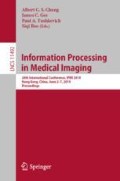Abstract
Discovering imaging biomarkers for autism spectrum disorder (ASD) is critical to help explain ASD and predict or monitor treatment outcomes. Toward this end, deep learning classifiers have recently been used for identifying ASD from functional magnetic resonance imaging (fMRI) with higher accuracy than traditional learning strategies. However, a key challenge with deep learning models is understanding just what image features the network is using, which can in turn be used to define the biomarkers. Current methods extract biomarkers, i.e., important features, by looking at how the prediction changes if “ignoring” one feature at a time. However, this can lead to serious errors if the features are conditionally dependent. In this work, we go beyond looking at only individual features by using Shapley value explanation (SVE) from cooperative game theory. Cooperative game theory is advantageous here because it directly considers the interaction between features and can be applied to any machine learning method, making it a novel, more accurate way of determining instance-wise biomarker importance from deep learning models. A barrier to using SVE is its computational complexity: \(2^N\) given N features. We explicitly reduce the complexity of SVE computation by two approaches based on the underlying graph structure of the input data: (1) only consider the centralized coalition of each feature; (2) a hierarchical pipeline which first clusters features into small communities, then applies SVE in each community. Monte Carlo approximation can be used for large permutation sets. We first validate our methods on the MNIST dataset and compare to human perception. Next, to insure plausibility of our biomarker results, we train a Random Forest (RF) to classify ASD/control subjects from fMRI and compare SVE results to standard RF-based feature importance. Finally, we show initial results on ranked fMRI biomarkers using SVE on a deep learning classifier for the ASD/control dataset.
Access this chapter
Tax calculation will be finalised at checkout
Purchases are for personal use only
References
Goldani, A.A.S., Downs, S.R., Widjaja, F., Lawton, B., Hendren, R.L.: Biomarkers in autism. Front. Psychiatry 5, 100 (2014)
Li, X., Dvornek, N.C., Zhuang, J., Ventola, P., Duncan, J.S.: Brain biomarker interpretation in ASD using deep learning and fMRI. In: Frangi, A.F., Schnabel, J.A., Davatzikos, C., Alberola-López, C., Fichtinger, G. (eds.) MICCAI 2018. LNCS, vol. 11072, pp. 206–214. Springer, Cham (2018). https://doi.org/10.1007/978-3-030-00931-1_24
Kaiser, M.D., et al.: Neural signatures of autism. Proc. Natl. Acad. Sci. 107(49), 21223–21228 (2010)
Lundberg, S.M., Lee, S.-I.: A unified approach to interpreting model predictions. In: Advances in Neural Information Processing Systems, pp. 4765–4774 (2017)
Chen, J., Song, L., Wainwright, M.J., Jordan, M.I.: L-shapley and C-shapley: efficient model interpretation for structured data. arXiv preprint arXiv:1808.02610 (2018)
Kononenko, I., Strumbelj, E.: An efficient explanation of individual classifications using game theory. J. Mach. Learn. Res. 11(Jan), 1–18 (2010)
Shapley, L.S.: A value for n-person games. Contrib. Theory Games 2(28), 307–317 (1953)
Zintgraf, L.M., Cohen, T.S., Adel, T., Welling, M.: Visualizing deep neural network decisions: prediction difference analysis. arXiv preprint arXiv:1702.04595 (2017)
Clauset, A., Newman, M.E., Moore, C.: Finding community structure in very large networks. Phys. Rev. E 70(6), 066111 (2004)
LeCun, Y., Bottou, L., Bengio, Y., Haffner, P.: Gradient-based learning applied to document recognition. Proc. IEEE 86(11), 2278–2324 (1998)
Achanta, R., Shaji, A., Smith, K., Lucchi, A., Fua, P., Süsstrunk, S.: Slic superpixels compared to state-of-the-art superpixel methods. IEEE Trans. Pattern Anal. Mach. Intell. 34(11), 2274–2282 (2012)
Tzourio-Mazoyer, N., et al.: Automated anatomical labeling of activations in SPM using a macroscopic anatomical parcellation of the MNI MRI single-subject brain. Neuroimage 15, 273–289 (2002)
Newman, M.: Networks. Oxford University Press, Oxford (2018)
Li, X., et al.: 2-channel convolutional 3D deep neural network (2CC3D) for fMRI analysis: ASD classification and feature learning. In: 2018 IEEE 15th International Symposium on Biomedical Imaging (ISBI 2018), pp. 1252–1255. IEEE (2018)
Young, R.C., Biggs, J.T., Ziegler, V.E., Meyer, D.A.: A rating scale for mania: reliability, validity and sensitivity. Br. J. Psychiatry 133(5), 429–435 (1978)
Yarkoni, T., Poldrack, R.A., Nichols, T.E., Van Essen, D.C., Wager, T.D.: Large-scale automated synthesis of human functional neuroimaging data. Nat. Methods 8(8), 665 (2011)
Author information
Authors and Affiliations
Corresponding author
Editor information
Editors and Affiliations
A Appendix: Proof of Theorem 2
A Appendix: Proof of Theorem 2
For any subset \(A\subset \mathcal {N}\), we use the short notation  and
and  , noting that \(A=U_{r}(A)\cup V_{r}(A)\). Rewriting Eq. (2) as
, noting that \(A=U_{r}(A)\cup V_{r}(A)\). Rewriting Eq. (2) as
and using
the expected error between \(\hat{\varPhi }_{r}^{C}(v_{\varvec{X}})\) and \(\varPhi _{r}(v_{\varvec{X}})\) is
where
with V short for \(V_{r}(A)\). Let \(W=\mathcal {N}\setminus (\mathcal {N}_{r}\cup V)\), \(Z=\mathcal {N}_{r}\setminus (\{r\}\cup U)\). Then
Since \(X_{r}\perp X_{V}\vert X_{Z}\), we have \(p(X_{V}\vert X_{W\cup Z\cup \{r\}})=p(X_{V}\vert X_{W\cup Z})\), and
We can multiply the quotient in Eq. (9) by \((\star )\),
We have \(p(X_{W\cup V\cup \{r\}}\vert Y,X_{Z})=p(X_{W\cup V}\vert Y,X_{Z})p(X_{r}\vert Y,X_{Z})\), since \(X_{W\cup V}\perp X_{r}\vert Y,X_{Z}\). So
Since \(X_{W}\perp X_{r}\vert Y,X_{Z}\), we have \(p(X_{W\cup \{r\}}\vert Y,X_{Z})=p(X_{W}\vert Y,X_{Z})p(X_{r}\vert Y,X_{Z})\). Hence \(\varDelta _{r}^{{\varvec{X}}}(U,A)=\log 1=0\). Therefore we have \(\mathbb {E}[\vert \hat{\varPhi }_{r}^{C}(v_{\varvec{X}})-\varPhi _{r}(v_{\varvec{X}})\vert ]=0\).
Rights and permissions
Copyright information
© 2019 Springer Nature Switzerland AG
About this paper
Cite this paper
Li, X., Dvornek, N.C., Zhou, Y., Zhuang, J., Ventola, P., Duncan, J.S. (2019). Efficient Interpretation of Deep Learning Models Using Graph Structure and Cooperative Game Theory: Application to ASD Biomarker Discovery. In: Chung, A., Gee, J., Yushkevich, P., Bao, S. (eds) Information Processing in Medical Imaging. IPMI 2019. Lecture Notes in Computer Science(), vol 11492. Springer, Cham. https://doi.org/10.1007/978-3-030-20351-1_56
Download citation
DOI: https://doi.org/10.1007/978-3-030-20351-1_56
Published:
Publisher Name: Springer, Cham
Print ISBN: 978-3-030-20350-4
Online ISBN: 978-3-030-20351-1
eBook Packages: Computer ScienceComputer Science (R0)

